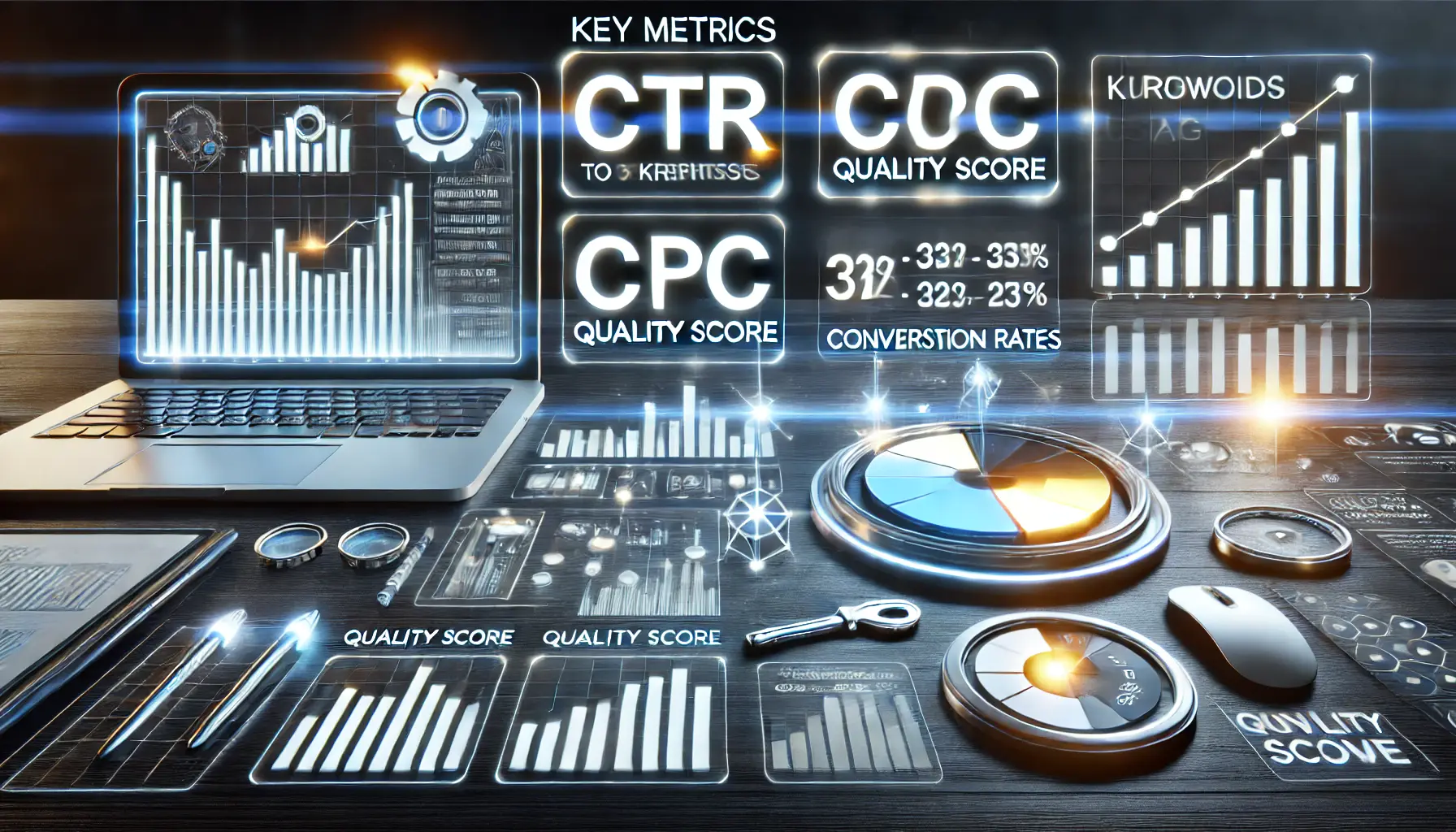Keywords are the cornerstone of any AdWords campaign that works.
The keywords are the bridge between the ad copy and user intent; using the right ones in the right way is everything when it comes to visibility, relevance, and ROIReturn on Investment, a measure of the profitability of an investment. of any marketing campaign.
But how do you ace their usage—not only to make ads resonate with target audiences but also to stay within budgets?
This article will guide you through every aspect of keywords usage in Google Ads, starting from the basics to advanced techniques, ensuring you gain the insights needed to optimize your campaigns effectively.
- Understanding the Basics of Keywords Usage in Google Ads
- Crafting an Effective Keyword Strategy
- Optimizing Keywords Usage for Better Performance
- Advanced Techniques in Keywords Usage
- Measuring the Success of Your Keyword Strategy
- Mastering Keywords Usage: Key Takeaways for Success
- Frequently Asked Questions About Keywords Usage in Google Ads
Understanding the Basics of Keywords Usage in Google Ads
Before diving into the complexities of keyword strategy, it’s crucial to understand the fundamentals of how keywords usage functions within Google Ads.
Keywords are essentially the terms and phrases that trigger your ads when users search for related content.
Mastering the basics of keywords usage will lay the foundation for a strong, results-driven campaign.

Illustration of the mechanics of keywords in digital marketing, emphasizing their connection to search engine activity.
What Are Keywords and How Do They Work?
Keywords are the specific words or phrases users type into search engines when looking for information, products, or services.
In Google Ads, these keywords act as triggers that determine when and where your ads appear.
For instance, if someone searches for ‘best running shoes,’ and you’ve included that keyword in your campaign, your ad might show up in their search results.
Google matches ads to keywords using a process called auctioning.
When a user enters a search query, Google evaluates all eligible ads based on factors like bid amount, ad relevance, and quality scoreA Google Ads metric that measures the relevance of your ads, keywords, and landing pages..
This ensures the most relevant and high-quality ads are displayed to users.

Visualizing the critical role of keywords in optimizing Google Ads campaigns through data and metrics.
Importance of Keywords Usage in Google Ads Campaigns
Effective keywords usage can make or break your campaign.
Here’s why:
- Better Targeting: Correct keywords mean that your advertisements are shown to users who actually seek what you have to offer.
- Cost Efficiency: It helps you save money by avoiding irrelevant clicks.
- Higher CTRs: Your ad content matched with user intent ensures higher click-through rates (CTRs).
- High Quality Score: For such focused ads, Google provides better placements and offers the benefits of lower cost per click.

Illustration of the process where Google matches search queries to relevant ads using keywords.
How Google Matches Ads to Keywords
Google uses several match types to align ads with keywords:
- Broad Match: Shows ads for searches that include synonyms or related terms.
- Phrase Match: Displays ads for queries that include your exact keyword phrase in the correct order.
- Exact Match: Limits ads to searches that precisely match your keyword.
- Negative Keywords: Excludes your ads from irrelevant searches, helping you avoid wasted clicks.
By understanding these match types, you can refine your keywords usage strategy and ensure that your ads are shown to the most relevant audience.

Visual representation of myths versus facts about keywords usage in digital marketing.
Common Misconceptions About Keywords Usage
Many advertisers fall into common traps when it comes to keywords usage.
Let’s debunk a few:
- More Keywords Mean Better Results: The reality is that too many keywords actually water down the focus of your campaign and budget.
- All Traffic Is Good Traffic: If you aren’t targeting correctly, you may attract clicks that simply don’t convert.
- Set It and Forget It: Keywords require regular monitoring and optimization to remain effective.
By addressing these misconceptions, you can avoid costly mistakes and realize the full potential of your Google Ads campaigns.
Understanding how keywords function within Google Ads is the cornerstone of building effective campaigns. It sets the stage for mastering advanced strategies.

Visualizing the steps to create an effective keyword strategy for digital marketing success.
Crafting an Effective Keyword Strategy
Creating a strong keyword strategy is the cornerstone of any successful Google Ads campaign.
It’s not just about picking random words that are relevant to your product or service; it’s about identifying and targeting the keywords that will drive meaningful traffic, reduce costs, and increase conversions.
An effective keywords usage strategy requires a combination of thorough research, precise planning, and ongoing optimization.

Highlighting the importance of keyword research in achieving campaign success.
The Role of Keyword Research in Campaign Success
Keyword research is the foundation of a robust keywords usage strategy.
It helps you identify the terms your target audience is searching for and ensures that your ads are aligned with their needs.
Without proper research, you risk targeting the wrong audience or wasting your budget on ineffective keywords.
- Understand User Intent: Distinguish between informational, navigational, and transactional intent to target the right audience at the right stage of the buying journey.
- Utilize Keyword Research Tools: Leverage tools like Google Keyword Planner, SEMrush, and Ahrefs to uncover high-volume, low-competition keywords.
- Focus on Long-Tail Keywords: These are highly specific phrases that may have lower search volumes but often result in better conversions due to their relevance.

Visualizing the process of selecting the appropriate match types for effective keyword strategy.
How to Choose the Right Match Types for Keywords
Choosing the correct match types for your keywords is essential to ensure your ads appear in the right place and at the right time.
Google Ads offers three main match types:
- Broad Match: Casts a wide net and includes variations, synonyms, and related terms. Best for achieving maximum reach but may require additional filtering with negative keywords.
- Phrase Match: Displays ads for queries that include your exact phrase, providing a balance between reach and relevance.
- Exact Match: Limits your ad display to exact keyword matches, offering the highest control but potentially reducing traffic volume.
Understanding these match types and their implications can help you optimize your budget and focus on attracting the most relevant audience.

Depicting advanced tools and techniques for discovering impactful keywords in digital marketing.
Tools and Techniques for Keyword Discovery
Discovering the right keywords is a continuous process.
Here are some techniques and tools to refine your keywords usage strategy:
- Competitor Analysis: Analyze the keywords your competitors are ranking for using tools like SpyFu or SEMrush.
- Google Search Completions: Use Google’s autocomplete suggestions and related search suggestions to expand your keyword list.
- Search Query Reports: Periodically review your campaign’s search terms report to identify useful keywords and exclude undesirable ones.

Highlighting frequent pitfalls in keyword strategies to improve digital marketing outcomes.
Common Keyword Strategy Mistakes to Avoid
Even advanced advertisers make mistakes while developing keywords usage strategies.
Some of the traps to avoid are:
- Not Excluding Negative Keywords: Failure to exclude irrelevant terms can lead to wasted money in ad spend.
- Overloading on Keywords: Adding too many keywords diminishes focus and makes a campaign hard to manage.
- Skipping Ongoing Optimization: Neglecting to review and adjust your keywords regularly can render them ineffective over time.
A properly researched and well-executed keywords usage strategy will ensure you maximize the effectiveness of your Google Ads campaign and drive real results for your business.
Developing a keyword strategy involves research and constant optimization. Focus on long-tail keywordsHighly specific keyword phrases that target niche audiences. to increase relevance and reduce costs.

Depicting the refinement of keyword strategies to achieve better performance in digital marketing.
Optimizing Keywords Usage for Better Performance
Once you identify the right keywords for your campaign, the next step is to optimize their usage for the best possible performance.
Optimization is not something you do once and forget; it is an ongoing process of tracking, analyzing, and adjusting your strategy to fit your goals and evolving audience behavior.
With the proper techniques in place, you can enhance your campaign’s efficiency and reach a highly relevant audience.

Demonstrating the impact of negative keywords on improving ROI in digital campaigns.
Using Negative Keywords to Improve ROI
Negative keywords are an essential tool for improving the return on investment (ROI) of your Google Ads campaigns.
By identifying and excluding irrelevant search terms, you can ensure your ads are only shown to users who are more likely to convert.
- Identify Irrelevant Traffic: Review your search terms report to spot keywords that generate clicks but fail to convert.
- Use a Tiered Approach: Start with broad negative keywords and refine your list over time as you analyze performance data.
- Exclude Competitor Names: Unless you are targeting competitors deliberately, excluding their brand names can prevent wasted ad spend.

Visualizing the strategic segmentation of keywords for precise audience targeting in digital campaigns.
Segmenting Keywords for Better Targeting
Segmentation of your keywords will enable you to build highly targeted ad groups that precisely match specific user intents.
This approach helps you enhance ad relevance, click-through rates (CTRs), and conversion rates.
- Organize by Intent: Separate keywords into categories such as informational, navigational, and transactional, and create targeted ads for each category.
- Create Specific Ad Groups: Each ad group should focus on one keyword theme for better relevance.
- Target Geographic Segments: Leverage location-based keywords to target audiences in specific regions.
Depicting the process of continuous tracking and revision of keywords for effective digital marketing.
Tracking and Revising Keywords Over Time
It is equally important to revisit your keywords regularly to maintain their relevance and effectiveness.
Google Ads provides valuable insights and tools to help you track performance and make data-driven decisions.
- Experiment with Match Types: Test different match types to see which works best for your campaign goals.
- Use Automated Rules: Establish rules that automatically adjust bids or pause underperforming keywords.

Visualizing the process of optimizing keywords specifically for mobile and desktop platforms.
Keyword Optimization for Mobile and Desktop Platforms
Today, optimization must be done across both mobile and desktop platforms.
User behavior varies across devices, and your keyword strategy should reflect these differences.
- Focus on Mobile-Friendly Keywords: Add shorter, conversational keywords to better match mobile search patterns.
- Adjust Bids by Device: Use bid adjustments to favor devices that deliver better performance.
- Analyze Device-Specific Metrics: Review performance metrics for mobile and desktop separately to determine where improvements are needed.

Visualizing the strategy of balancing high-competition and low-competition keywords in digital campaigns.
Balancing High-Competition and Low-Competition Keywords
The proper balance between high-competition and low-competition keywords is what will make a strategy cost-effective.
High-competition keywords provide visibility but are costly, while low-competition keywords are relatively cheap and can help in reaching a niche audience.
- Mix and Match: Combine both types to achieve a balance between reach and cost efficiency.
- Focus on Niche Keywords: Low-competition, niche keywords generally generate more conversions because of their specificity.
- Monitor Trends: Stay updated on emerging keywords and adjust your strategy to capitalize on new opportunities.
By continuously optimizing your keywords usage, you can ensure that your Google Ads campaigns deliver consistent and meaningful results, helping you achieve your marketing goals efficiently.
Optimization requires constant monitoring and adjustments. Utilize negative keywordsKeywords that prevent ads from appearing in irrelevant searches. and refine ad groups for better performance.

Exploring advanced strategies and tools for optimizing keyword usage in digital marketing.
Advanced Techniques in Keywords Usage
As you gain experience managing Google Ads campaigns, you’ll want to explore advanced techniques for keywords usage to further enhance performance.
These methods can help you reach niche audiences, improve your ad relevance, and gain a competitive edge.
By leveraging these strategies, you can refine your campaigns to deliver even better results.

Highlighting the power of long-tail keywords in reaching niche audiences effectively.
Leveraging Long-Tail Keywords for Niche Audiences
Long-tail keywords are more specific phrases that generally have lower search volumes but higher intent.
These keywords are invaluable for targeting niche audiences who are further along in the buying journey.
- Higher Conversion Rates: They attract users with specific needs, increasing the chances of conversion.
- Low Competition: These keywords are often less competitive and more cost-effective to target.
- Better Audience Match: Long-tail keywords help you tailor your ads to highly specific queries, improving relevance and engagement.
To find long-tail keywords, use tools like AnswerThePublic, Google Autocomplete, and keyword research tools that identify question-based queries.

Exploring the adaptability and precision of dynamic keyword insertion in digital marketing.
Dynamic Keyword Insertion: Benefits and Risks
Dynamic Keyword Insertion (DKI) automatically adjusts your ad copy to include the user’s search query.
This technique can increase the relevance of your ads, but it must be implemented carefully.
- Benefits: DKI improves ad relevance, increases CTR, and potentially boosts Quality Score.
- Risks: If done incorrectly, your ad copy might appear misformatted or nonsensical. Always test your dynamic ads to ensure they display properly.
- Best Practices: Use DKI only with tightly grouped ad groups and carefully selected keywords to avoid irrelevant or awkward ad copy.

Visualizing the significance of Quality Score in optimizing keywords for digital campaigns.
Quality Score and Its Impact on Keywords Explained
Google Ads assigns a Quality Score to your keywords, which determines ad ranking and cost-per-click (CPCCost Per Click, the amount you pay each time someone clicks on your ad.).
A higher Quality Score can result in better ad placement at a lower cost.
- Ad Relevance: Ensure your ad copy is highly related to the target keywords.
- Landing Page Experience: Optimize your landing page to work seamlessly and precisely meet user expectations.
- Expected CTR: Write compelling ad copy that encourages clicks while maintaining relevance.
Regularly monitor your Quality Scores and make adjustments to improve them, such as refining your keywords, enhancing your ad copy, and optimizing your landing pages.

Exploring the role of AI and automation in revolutionizing keyword management for digital campaigns.
Using AI and Automation in Keyword Management
Artificial intelligence and automation tools can improve efficiency and performance in keyword management.
These tools analyze large data sets to provide actionable insights and optimize campaigns in real time.
- Smart Bidding: Automate your bidding for the highest possible ROI based on your campaign goals.
- Keyword Suggestions: Discover new, high-performing keywords with AI-powered tools.
- Performance Monitoring: Automate performance tracking to uncover trends and drive data-informed decisions.
Platforms like Google Ads’ automated recommendations and third-party tools such as Optmyzr or Adzooma can help you integrate AI into your strategy.

Visualizing the use of competitor analysis to refine and optimize keyword strategies.
Competitor Analysis to Refine Keyword Strategies
Competitor analysis provides valuable insights into the keywords your competitors are targeting and how their campaigns perform.
By analyzing this data, you can identify gaps and opportunities to strengthen your own strategy.
- Analyze Ad Copy: Examine competitor ads to understand their messaging and keyword focus.
- Use Spy Tools: Tools like SEMrush, SpyFu, or iSpionage can reveal competitor keywords and ad performance.
- Benchmark Performance: Compare your campaigns against competitors to identify areas for improvement.
By applying these advanced techniques to your keywords usage strategy, you can outperform your competitors and achieve even better results in your Google Ads campaigns.
Advanced strategies like long-tail keywords and AI tools can give a competitive edge by enhancing targeting precision and reducing costs.

Visualizing the key metrics for evaluating the success of keyword strategies in digital marketing.
Measuring the Success of Your Keyword Strategy
Measuring the success of your keywords usage strategy is crucial to ensure your Google Ads campaigns are delivering the expected results.
By analyzing performance metrics, conducting audits, and continuously optimizing your efforts, you can refine your strategy and maximize its effectiveness.
Here’s how to measure and improve your keyword strategy.

Visualizing essential metrics for tracking and optimizing keywords usage in digital campaigns.
Key Metrics to Track in Keywords Usage
Tracking the right metrics is essential to understand how your keywords are performing.
Some of the most important metrics to monitor include:
- Click-Through Rate (CTR): A high CTR indicates that your ad is relevant to the search queries triggered by your keywords.
- Conversion Rate: This measures how often users take the desired action after clicking on your ad, such as making a purchase or signing up.
- Cost Per Click (CPC): Monitor how much you’re paying for each click and aim to lower this cost without sacrificing quality traffic.
- Quality Score: Keep an eye on Google’s Quality Score for your keywords to ensure your ads are competitive and cost-effective.
- Search Impression Share: This metric shows how often your ad appears compared to the total available impressions for your keywords.

Visualizing the process of evaluating conversion rates and ROI for optimizing digital marketing strategies.
Analyzing Conversion Rates and ROI
Conversion rates and ROI are key indicators of the success of your keywords usage strategy.
Here’s how to analyze and improve them:
- Segment Data: Break down conversion data by keyword, ad group, and campaign to identify top-performing keywords.
- Use Attribution Models: Apply different attribution models to understand which keywords contribute most to conversions.
- Focus on High-Value Actions: Prioritize conversions that drive the highest value for your business, such as sales or lead generation.

Visualizing the steps and tools involved in conducting an effective keyword performance audit.
How to Conduct a Keyword Performance Audit
A regular keyword performance audit helps you identify strengths, weaknesses, and opportunities within your campaigns.
Follow these steps to conduct an effective audit:
- Review Search Terms: Analyze your search terms report to identify irrelevant or low-performing keywords and exclude them.
- Review Match Types: Reevaluate the selected match types to ensure they align with your campaign objectives and adjust where necessary.
- Study Negative Keywords: Update the list of negative keywords to ensure proper filtering of irrelevant traffic.

Visualizing the role of A/B testing in optimizing keyword performance through comparative analysis.
Leverage A/B Testing for Improved Keyword Performance
A/B testing is a surefire way to experiment with your keyword strategy in different ways.
By testing variations, you can learn what works best with your audience and optimize accordingly.
- Test Ad Copy: Create variations of your ad copy that use different keyword placements and tones.
- Experiment with Match Types: Compare broad, phrase, and exact match types to see which performs the best.
- Evaluate Landing Pages: Test different landing pages to see which one converts better for specific keywords.

Visualizing the integration of keyword usage insights with broader marketing strategies for enhanced results.
Integrating Keywords Usage Insights Into Broader Marketing Goals
Your keyword strategy doesn’t exist in isolation—it should align with your broader marketing objectives.
Here’s how to integrate insights from keywords usage into your overall strategy:
- Align Keywords with Content: Use keyword data to inform your blog posts, social media content, and email marketing campaigns.
- Support SEO Efforts: Identify high-performing paid keywords that can be targeted for organic ranking improvements.
- Enhance Audience Targeting: Refine your audience personas with keyword insights to better understand their needs.
By continuing to measure the performance of your keywords usage strategy, you can ensure that your Google Ads campaigns are not only measurable but also effective in driving your overall business goals.
- Monitor metrics like CTR, CPC, and Quality Score to evaluate success.
- Regular audits help refine strategy and improve campaign ROI.

Visualizing the expertise required to master keyword strategies for digital marketing success.
Mastering Keywords Usage: Key Takeaways for Success
The journey to mastering keywords usage in Google Ads is both an art and a science.
From understanding the basics to implementing advanced techniques, every aspect of your strategy plays a crucial role in optimizing your campaigns.
Let’s summarize the key insights and actionable steps to ensure your keyword strategy is effective and impactful.

Visualizing the essential principles that form the foundation of effective keyword strategies.
The Foundations of Keywords Usage
Success begins with a strong foundation.
When you understand what keywords are and how they work within Google Ads, you can align your campaigns with user intent and drive meaningful results.
Remember these essentials:
- Conduct thorough keyword research to find the most relevant and high-performing keywords.
- Structure your keywords according to user intent so that your ads resonate with your target audience.
- Continuously refine your keyword lists to adapt to changing trends and behaviors.

Visualizing the process of refining and improving digital marketing strategies for optimal results.
Optimizing and Refining Your Strategy
Optimization is an ongoing process that ensures your keywords usage remains effective over time.
Key optimization practices include:
- Leverage negative keywords to eliminate irrelevant traffic and improve ROI.
- Experiment with different match types to strike the right balance between reach and precision.
- Segment your keywords into tightly themed ad groups to improve targeting relevance in ad display.

Visualizing advanced strategies and tools for gaining a competitive advantage in digital marketing.
Advanced Techniques for Competitive Advantage
As your campaigns mature, advanced techniques can give you a competitive edge.
These include:
- Tapping into long-tail keywords to capture specific audience intent in niche markets.
- Applying dynamic keyword insertion carefully to enhance ad relevance without compromising quality.
- Incorporating AI tools and automation to streamline management and identify new opportunities.

Visualizing the continuous process of measuring success and adapting strategies in digital marketing.
Measuring Success and Adapting
Measuring the performance of your keywords usage strategy is critical to identifying areas of improvement.
Focus on these metrics and practices:
- Track metrics like CTR, CPC, Quality Score, and conversion rates to evaluate keyword performance.
- Conduct regular keyword audits to identify underperforming terms and optimize your campaigns.
- Use A/B testing to experiment with different elements and uncover the most effective approaches.

Visualizing the alignment of keyword strategies with overarching marketing objectives for enhanced effectiveness.
Integrating Keywords Insights Into Broader Goals
Your keyword strategy should align seamlessly with your overall marketing objectives.
By integrating insights from your campaigns, you can:
- Inform your content marketing efforts with data-driven topics and themes.
- Enhance your SEO strategy by targeting high-performing keywords organically.
- Refine your audience personas for more personalized and effective campaigns.
The use of keywords in Google Ads is dynamic.
By building advanced techniques and ongoing optimization on a strong foundation, you can create campaigns that generate meaningful results as part of a greater business outcome.
The power of keywords doesn’t just come from choosing them but from using them effectively to connect with your targeted audience.
Mastering keywords involves understanding their use, optimizing regularly, and leveraging advanced techniques for sustained success.

Visualizing common questions and insights about keyword usage in Google Ads.
Your campaigns can be managed by an agency specialized in Google Ads, check out our service page.
Frequently Asked Questions About Keywords Usage in Google Ads
Some of the frequently asked questions about keywords usage in Google Ads are answered below.
The answers will provide clarity and actionable insights for those interested in learning more about improving their campaigns.
Keywords are specific words or phrases that trigger your ads when users search for related content.
They help connect your ad to potential customers searching for products or services like yours.
Negative keywords prevent your ads from appearing in irrelevant searches, saving your budget and ensuring your ads reach the most relevant audience, ultimately improving ROI and campaign performance.
Use tools like Google Keyword Planner, SEMrush, or Ahrefs to research high-volume, low-competition keywords.
Focus on user intent and analyze competitors to identify effective keywords for your audience.
Long-tail keywords are highly specific phrases with lower search volume but higher intent.
They often result in better conversions because they target users closer to making a decision or purchase.
Match types determine how closely a search query must match your keyword for your ad to show.
Broad match increases reach, while phrase and exact matches offer more precision.
Quality Score measures the relevance of your ads, keywords, and landing pages.
A higher Quality Score leads to better ad placement and lower costs-per-click (CPC).
Track metrics like click-through rate (CTRClick-Through Rate, the ratio of users who click on an ad to the number of total users who view it.), cost-per-click (CPC), conversion rates, and Quality Score.
Regularly review these metrics to adjust and optimize your keyword strategy effectively.
Dynamic keyword insertion automatically updates ad text with the user’s search query.
It increases relevance but must be used carefully to avoid nonsensical or misaligned ad copy.
Regularly review and update your keywords based on campaign performance and market trends.
Conduct keyword audits monthly or quarterly to ensure they align with your current goals and audience behavior.














